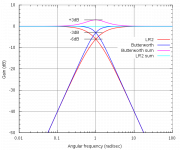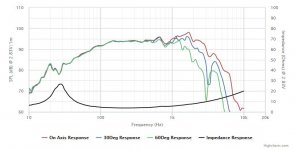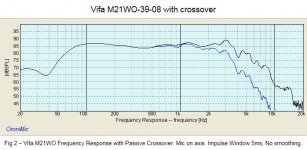I think you'll find there are a number of other factors that creep in and change this.So at 4.5/60 it is not completely "fixed" yet, not until you go full way 3dB/90.
There is a considerable difference between the D'Appolito configuration and a conventional MTM.maybe MTM is the answer
Below is an example of a second order Butterworth summing to +3dB response.regarding the order
Attachments
Well, if I kept on saying Butterworth's FR is flat, obviously I have been referring to the odd-order variants. I did say that in the beginning but I couldn't have possibly said that every time I utter the word.
Sorry if I missed that, but it is the three dimensional aspects of a crossover that are of further concern than the electrical aspects of the crossover or compensating for the drivers response.
I think you'll find there are a number of other factors that creep in and change this.
In theory... I tend to say things that are true in theory.
Yes. In the real world, there are many other things that have to be factored in.
Sorry if I missed that, but it is the three dimensional aspects of a crossover that are of further concern than the electrical aspects of the crossover or compensating for the drivers response.
No it wasn't you but it was me who jumped/skipped certain steps. My express goal was to "fix" LR until its power response was flat but keeping its flat FR. That had to involve a change of order (no pun intended) to make the change of angle happen. The OP did say ignore the order.
Now this is what I failed to grasp: the crossover can only affect the tweeter/midrange axis so how does it affect things in a 3 dimensional way? Please elaborate on that. (Did it had something to do with horns that are not conical? I don't know.)
As long as woofer plays, the beaming is determined by how much of the totality of the cone contributes to emission: at high frequencies only the center emits because of the vicinity of the VC former that transfers the motus.
😱
😱
Yes. That is hardly surprising as the off-axis response drop-off means less radiated energy. The crossover slope has a direct impact on this. Is this what is meant by the three-dimensional aspect of the crossover?
which is good, because we have two ears placed laterally .Yes. That is hardly surprising as the off-axis response drop-off means less radiated energy.
About three-D XO, IDK ! Probably it refers to the sound that has magnitude, versus and direction 🙄
(This doesn't commit you to even order Butterworth slopes either. Exploring parallel realizations of odd order series networks will give you the same result.)
This part really got me very much interested. A crossover is either series or parallel, right? Would you mind explaining in detail how this was done?
About three-D XO, IDK ! Probably it refers to the sound that has magnitude, versus and direction 🙄
Sorry for the mix up. I mistook that you were answering my question.
A crossover starts in design with the physical aspects. There will be driver separation. This may cause comb filtering or a variation in room interaction. The baffle design may or may not include horns. There may be room reflections that are expected or wanted, or that are absorbed or avoided in the first place. These things will affect room power at least.the crossover can only affect the tweeter/midrange axis so how does it affect things in a 3 dimensional way? Please elaborate on that.
There can be in phase combining at the listening axis with an 18dB/octave slope. The fact that LR is specified at 2nd, 4th order etc is not related to the current issue.That had to involve a change of order (no pun intended) to make the change of angle happen.
It's all terribly complicated, isn't it. You could spend years on this stuff. Oh wait... we do! 😀
Here's the familiar phase-aligned BW2 and LR2 frequency responses, courtesy of AllenB:
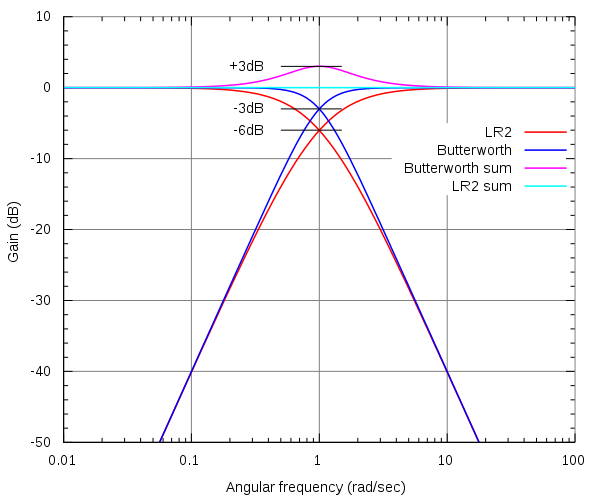
The BW2 looks bad on frequency response, but conceals a secret. It has overall flat power response and flat impedance. Both good things, IMO.
And we can fix the frequency response with a 90 degree phase shift in a crossover by mucking up the time alignment between the two drivers.
This is what the BBC did in the LS3/5A speaker by stepping the bass back on the baffle. A surprising solution that worked for a lot of people. Harbeth still do this:
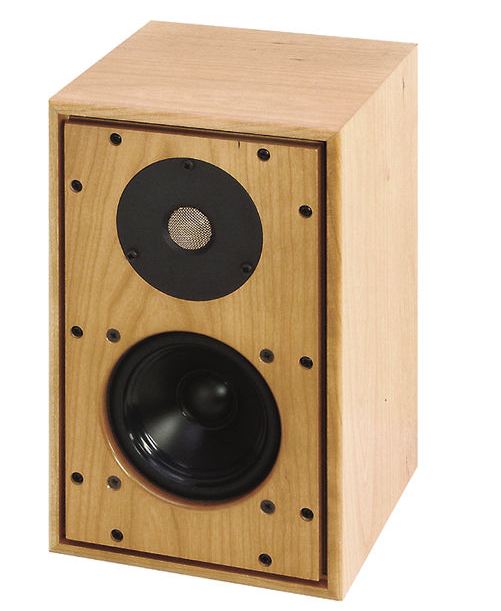
This is not to advocate Butterworth. Linkwitz-Riley has strengths too. I think the debate will rage on, unless we concede both solutions have strengths and weaknesses. Let's not go into lobing and combing and distortion here either... 😱
I could talk about group delay now. Or the useful Vifa M21WO39-04 woofer which looks like it could run almost crossoverless or maybe just a bass coil for 2kHz. So I'll stop here with two interesting images.
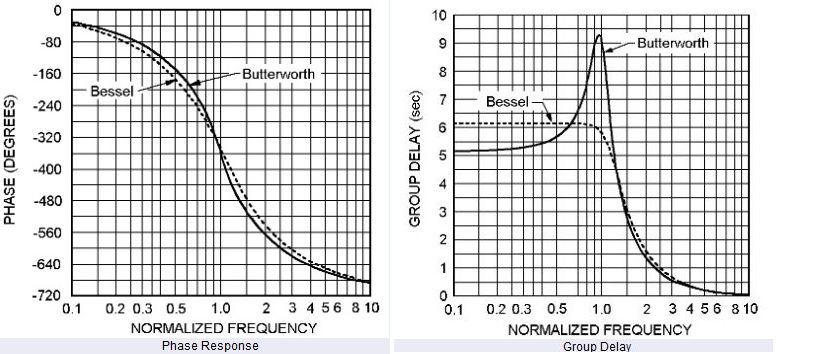
Here's the familiar phase-aligned BW2 and LR2 frequency responses, courtesy of AllenB:
The BW2 looks bad on frequency response, but conceals a secret. It has overall flat power response and flat impedance. Both good things, IMO.
And we can fix the frequency response with a 90 degree phase shift in a crossover by mucking up the time alignment between the two drivers.
This is what the BBC did in the LS3/5A speaker by stepping the bass back on the baffle. A surprising solution that worked for a lot of people. Harbeth still do this:
This is not to advocate Butterworth. Linkwitz-Riley has strengths too. I think the debate will rage on, unless we concede both solutions have strengths and weaknesses. Let's not go into lobing and combing and distortion here either... 😱
I could talk about group delay now. Or the useful Vifa M21WO39-04 woofer which looks like it could run almost crossoverless or maybe just a bass coil for 2kHz. So I'll stop here with two interesting images.
Attachments
Hi andreaFrom this point, problems appeared to tweeter. Cutting it high it sounded thin and clinking; cutting lower it sounded with a quite "metallic" taste; cutting even lower trebles was better but "ssss" and cymbals are in big evidence, even lowering trebles level....
You get these issues when the woofer and the tweeter are not crossing properly.
Using an 8" woofer with a 1" dome tweeter is quite challenging. I recently did one with a HiVi M8a and believe or not, a HiVi TN-28 tweeter ( Junco-II ). I actually crossed them at 1.5kHz.
Prior to that, it was a vintage Vifa M21WO-39-08, again with a TN-28 ( Junco ). The M21WO has a nice frequency extension so I was able to cross higher at about 3kHz. It's not the ideal cross point but my intention was to get something running so that I can hear how they sound like. Surprising, the Junco sounds pretty good on-axis.
I plan to replace the TN28 with a Morel CAT378 in future. I'm confident it will be a better match.
Always a pleasure to read your stuff, Michael. You just might be one of my speaker heroes, along with Lynn Olson and Joachim Gerhardt and Troels Gravesen and Roy Allison... 😀
That Vifa M21 has many variants with different sized magnets, surrounds and impedance. But is also remarkably similar to the Peerless 830869 we started with.
Your 3kHz crossover (attached Image) must be just a coil and a bit of impedance correction at a guess. I always find a negative polarity 3rd or 4th order tweeter filter works well with that on a flat baffle. This is what KEF did with that 8" plus 1" combo. You take your beating on 3kHz breakup from the bass unit and a glaring dispersion mismatch. It's not too intrusive IMO.
One of the best 8" paper plus 3/4" mylar speakers I have ever heard is this Wharfedale Shelton XP2. 6 element BW3, I reckon, but I couldn't unglue the crossover to be sure. It can be done.
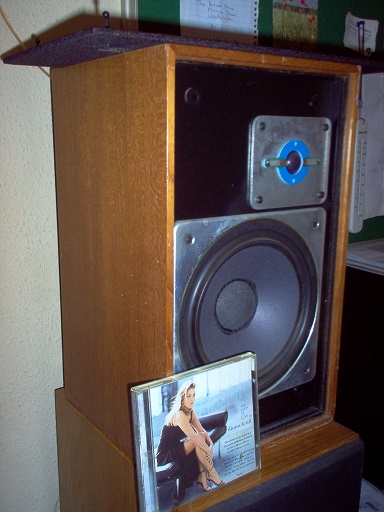
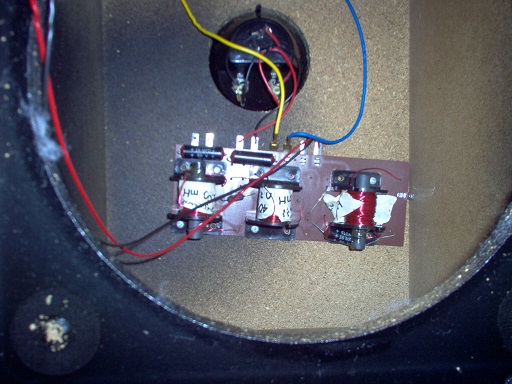
That Vifa M21 has many variants with different sized magnets, surrounds and impedance. But is also remarkably similar to the Peerless 830869 we started with.
Your 3kHz crossover (attached Image) must be just a coil and a bit of impedance correction at a guess. I always find a negative polarity 3rd or 4th order tweeter filter works well with that on a flat baffle. This is what KEF did with that 8" plus 1" combo. You take your beating on 3kHz breakup from the bass unit and a glaring dispersion mismatch. It's not too intrusive IMO.
One of the best 8" paper plus 3/4" mylar speakers I have ever heard is this Wharfedale Shelton XP2. 6 element BW3, I reckon, but I couldn't unglue the crossover to be sure. It can be done.
Attachments
Last edited:
Hi Steve
Thanks for your kind words. I'm just having fun.
Yes, there were a few versions of the M21 but I think the one with the strongest magnet is the M21WO. It is a wonderful woofer. It's a shame it's discontinued.
The FR plot of the M21WO is 2nd order electrical. So is the TN28. I am sure I can cross the M21WO with the CAT378 at probably 1.5kHz.
I do have the 830869 but I have yet to get the best out of it. Maybe I'm looking at it all wrong.
Thanks for your kind words. I'm just having fun.
Yes, there were a few versions of the M21 but I think the one with the strongest magnet is the M21WO. It is a wonderful woofer. It's a shame it's discontinued.
The FR plot of the M21WO is 2nd order electrical. So is the TN28. I am sure I can cross the M21WO with the CAT378 at probably 1.5kHz.
I do have the 830869 but I have yet to get the best out of it. Maybe I'm looking at it all wrong.
Last edited:
Thanks Steve. I realise that I meant to say that we could create an in phase and 0dB summing 18dB/octave sloped cross where the response is -6dB at the crossover.Here's the familiar phase-aligned BW2 and LR2 frequency responses
Hi andrea
You get these issues when the woofer and the tweeter are not crossing properly.
Hello Michael, you're welcome, I think probably I'm having cutting too low the woofer with the anti-breakup cap and so tweeter's treble remains low-truncated and incomplete, sounding bad. I'll try to enlight the effect of anti-breakup RC and to smooth a bit the high-pass curve increasing R series with tweeter coil. Unfortunately in this step simulation doesn't help at all, every of that seems good..
The spirit of my original question was if creating a more peaking cut-off curve to regain what misses from woofer can affect sound quality, but now I think it wasn't that the reason, maybe I've to regain something just from it, tweeter can't do miracles.
A crossover starts in design with the physical aspects. There will be driver separation. This may cause comb filtering or a variation in room interaction. The baffle design may or may not include horns. There may be room reflections that are expected or wanted, or that are absorbed or avoided in the first place. These things will affect room power at least.
I see now. Thanks! You are right, the term "crossover" includes all the acoustic transitions as well, not just electrical ones. (I knock my head for missing something as obvious as this.)
Case in point the abrupt off-axis transition from a 8" to 1" is a part of the (acoustic) crossover.
- Status
- Not open for further replies.
- Home
- Loudspeakers
- Multi-Way
- Differences in tweeter's sound by different kind of crossover
